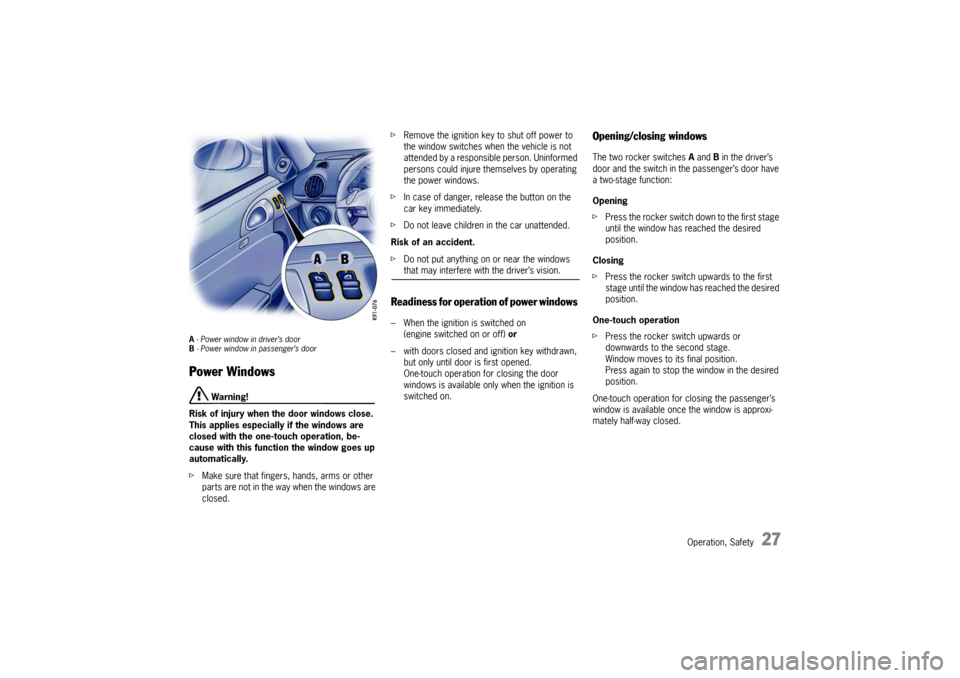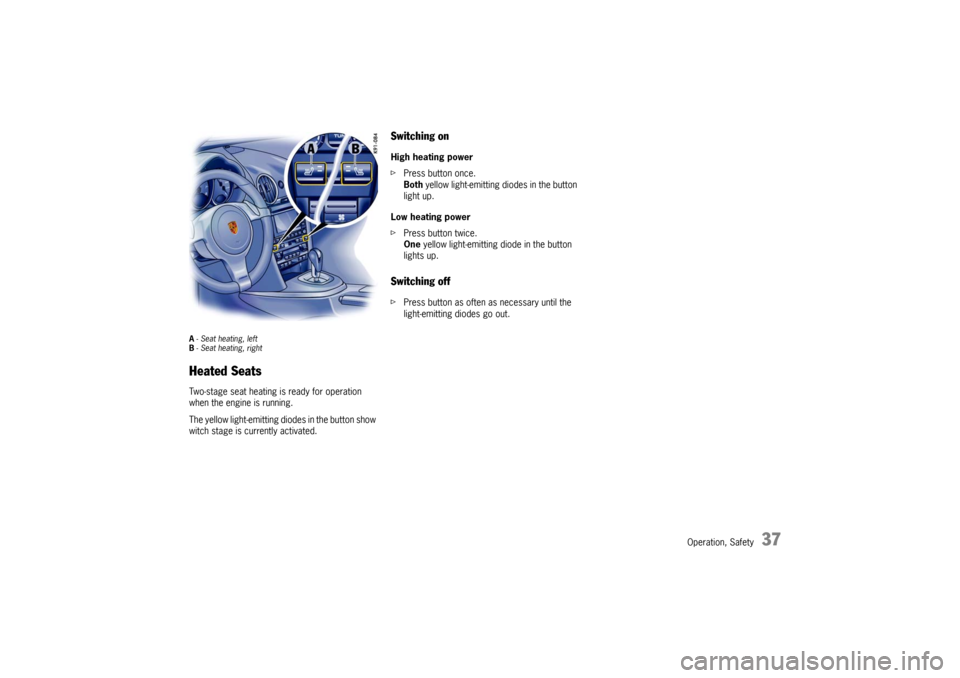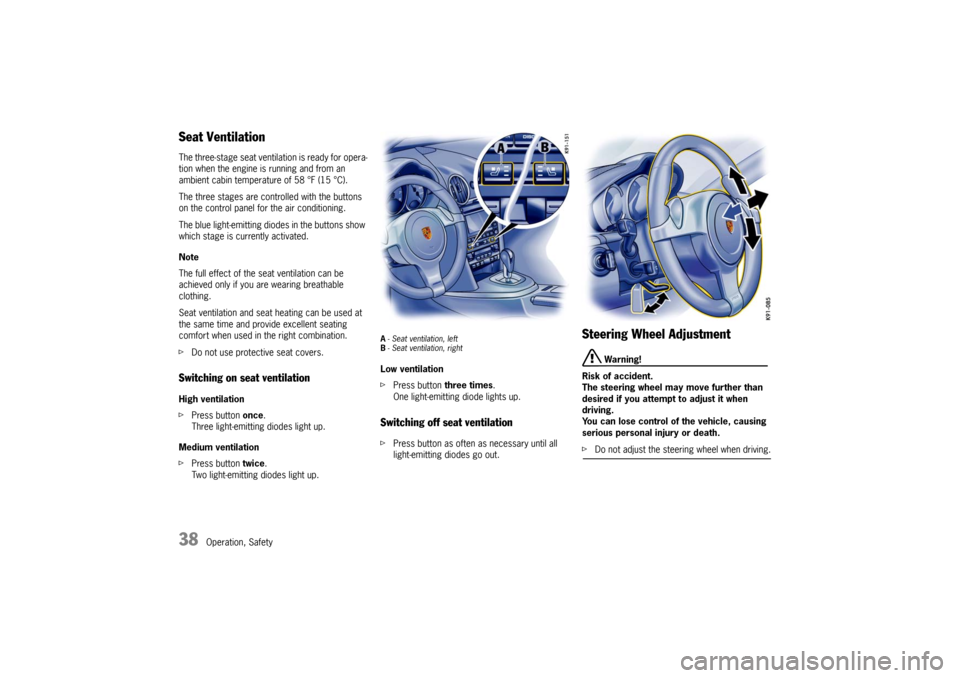engine PORSCHE CAYMAN 2009 1.G User Guide
[x] Cancel search | Manufacturer: PORSCHE, Model Year: 2009, Model line: CAYMAN, Model: PORSCHE CAYMAN 2009 1.GPages: 284, PDF Size: 5.94 MB
Page 17 of 284

Operation, Safety
15
Keys fPlease see the chapter “ALARM SYSTEM, PAS-
SENGER COMPARTMENT MONITORING” on
Page 25.
f Please see the chapter “CENTRAL LOCKING IN
CARS WITHOUT ALARM SYSTEM” on Page 19.
f Please see the chapter “CENTRAL LOCKING IN
CARS WITH ALARM SYSTEM” on Page 21.
Two car keys are supplied with your Porsche.
These keys operate all the locks on your vehicle.
f Be careful with your car keys: do not part with
them except under exceptional circumstances.
f To avoid battery run-down, always remove the
ignition key from the ignition lock. Emergency operationfPlease see the chapter “EMERGENCY OPERA-
TION – PULLING OUT THE IGNITION KEY” on
Page 74.
Replacement keys Replacement car keys can be obtained only from
your authorized Porsche dealer, and this can
sometimes be very time-consuming.
You should therefore always keep a spare key on
your person.
Keep it in a safe place (e.g. wallet), but under no
circumstances in or on the vehicle.
The key codes of new keys have to be “reported”
to the car control unit by your authorized Porsche
dealer.
A total of 6 car keys can be reported to the control
unit.
Disabling key codes
If a key is lost, the key codes can be disabled by
an authorized Porsche dealer.
All the remaining car keys are required for this pur-
pose.
Disabling the code ensures that the car can be
started only using authorized keys.
Note
f Please note that the other locks can still be
opened with the disabled key.
Immobilizer There is a transponder (an electronic component)
in the key grip, conta ining a stored code.
When the ignition is switch ed on, the ignition lock
checks the code.
The immobilizer can be deactivated and the en-
gine started only using an authorized ignition key.
Switching off the immobilizer
f Insert the ignition key into the ignition lock.
If the ignition is left on for more than 2 minutes
without the engine being started, the immobilizer
is switched on again.
f If this happens, turn the ignition key back to
position 3 (ignition off) before starting the
engine. The immobilizer is switched off again,
and the engine can be started.
f Please see the chapter “IGNITION/STARTER
SWITCH WITH ANTI-THEFT STEERING LOCK”
on Page 72.
Switching on the immobilizer
f Remove ignition key.Security Wheel Bolts fIf wheels have to be removed during a work-
shop visit, do not forget to hand over the sock-
et for the security wheel bolts along with the
car key.
Page 22 of 284

20
Operation, Safety
The central locking switch on the dashboard lets
you lock and unlock both doors electrically.
Note
If the doors are locked with the key or remote
control, they can not be opened by pressing the
central locking switch. Locking
f
Press the rocker-switch.
Indicator light in the rocker switch lights up if
ignition is on.
If the doors were locked with the central
locking switch, they can be opened by pulling
the inner door handle twice.
Unlocking
f Press the rocker-switch.
Indicator light goes off.
Automatic door locking Your authorized Porsche dealer can program
diverse types of automatic door locking in the
control unit of the central locking system.
Ty p e 1
Doors lock automatically when the ignition is
switched on.
Ty p e 2
Doors lock automatically when a speed of
3 - 6 mph (5 - 10 km/h) is exceeded. Ty p e 3
Doors lock automatically
when the ignition is
switched on. If doors are opened with the engine
running, they lock again automatically when a
speed of 3 - 6 mph (5 - 10 km/h) is exceeded.
Ty p e 4
The doors do not lock automatically.
Note
Automatically locked doors can be unlocked with
the central locking button or opened by pulling on
the inside door handle twice.
On vehicles with the Sport Chrono Package Plus,
the PCM can be used to activate automatic door
locking.
f Please see the chapter ”Individual Memory“ in
the separate PCM operating instructions.
Warning!
In an emergency situation where you need to
exit the car through an automatically locked
door, remember the following procedure to
open the door.
f Unlock the doors by pressing the central
locking button or
f pull the inside door handle twice to open the door.
Central locking switch
Page 26 of 284

24
Operation, Safety
Automatic door locking Your authorized Porsche dealer can program
diverse types of automatic door locking in the
control unit of the central locking system.
Ty p e 1
Doors lock automatically when the ignition is
switched on.
Ty p e 2
Doors lock automatically when a speed of
3 - 6 mph (5 - 10 km/h) is exceeded.
Ty p e 3
Doors lock automatically when the ignition is
switched on. If doors are opened with the engine
running, they lock again automatically when a
speed of 3 - 6 mph (5 - 10 km/h) is exceeded.
Ty p e 4
The doors do not lock automatically. Note
Automatically locked doors can be unlocked with
the central locking button or opened by pulling on
the inside door handle twice.
On vehicles with the Sport Chrono Package Plus,
the PCM can be used to activate automatic door
locking.
f
Please see the chapter ”Individual Memory“ in
the separate PCM operating instructions.
Warning!
In an emergency situation where you need to
exit the car through an automatically locked
door, remember the following procedure to
open the door.
f Unlock the doors by pressing the central
locking button or
f pull the inside door handle twice to open the door.
Fault indication A double horn signal during locking indicates a
defect in the central locking or alarm system.
f Have the defect remed ied at an authorized
Porsche dealer. Overload protection If the central locking system is operated more
than ten times within a minute, further operation is
blocked for 30 seconds.
Page 29 of 284

Operation, Safety
27
A - Power window in driver’s door
B - Power window in passenger’s doorPower Windows
Warning!
Risk of injury when the door windows close.
This applies especially if the windows are
closed with the one-touch operation, be-
cause with this function the window goes up
automatically.
f Make sure that fingers, hands, arms or other
parts are not in the way when the windows are
closed. f
Remove the ignition key to shut off power to
the window switches when the vehicle is not
attended by a responsible person. Uninformed
persons could injure themselves by operating
the power windows.
f In case of danger, release the button on the
car key immediately.
f Do not leave children in the car unattended.
Risk of an accident.
f Do not put anything on or near the windows
that may interfere with the driver’s vision.
Readiness for operation of power windows – When the ignition is switched on
(engine switched on or off) or
– with doors closed and ignition key withdrawn, but only until door is first opened.
One-touch operation for closing the door
windows is available only when the ignition is
switched on.
Opening/closing windowsThe two rocker switches A and B in the driver’s
door and the switch in the passenger’s door have
a two-stage function:
Opening
f Press the rocker switch down to the first stage
until the window has reached the desired
position.
Closing
f Press the rocker switch upwards to the first
stage until the window ha s reached the desired
position.
One-touch operation
f Press the rocker switch upwards or
downwards to the second stage.
Window moves to its final position.
Press again to stop the window in the desired
position.
One-touch operation for closing the passenger’s
window is available once the window is approxi-
mately half-way closed.
Page 39 of 284

Operation, Safety
37
A- Seat heating, left
B -Seat heating, rightHeated SeatsTwo-stage seat heating is ready for operation
when the engine is running.
The yellow light-emitting diodes in the button show
witch stage is currently activated.
Switching onHigh heating power
f Press button once.
Both yellow light-emitting diodes in the button
light up.
Low heating power
f Press button twice.
One yellow light-emitting diode in the button
lights up.Switching offf Press button as often as necessary until the
light-emitting diodes go out.
Page 40 of 284

38
Operation, Safety
Seat VentilationThe three-stage seat ventilation is ready for opera-
tion when the engine is running and from an
ambient cabin temperature of 58 °F (15 °C).
The three stages are controlled with the buttons
on the control panel for the air conditioning.
The blue light-emitting diodes in the buttons show
which stage is currently activated.
Note
The full effect of the seat ventilation can be
achieved only if you are wearing breathable
clothing.
Seat ventilation and seat heating can be used at
the same time and provide excellent seating
comfort when used in the right combination.
f Do not use protective seat covers.Switching on seat ventilationHigh ventilation
fPress button once.
Three light-emitting diodes light up.
Medium ventilation
f Press button twice.
Two light-emitting diodes light up.
A - Seat ventilation, left
B - Seat ventilation, rightLow ventilation
f Press button three times.
One light-emitting diode lights up.Switching off seat ventilationf Press button as often as necessary until all
light-emitting diodes go out.
Steering Wheel Adjustment
Warning!
Risk of accident.
The steering wheel may move further than
desired if you attempt to adjust it when
driving.
You can lose control of the vehicle, causing
serious personal injury or death.
f Do not adjust the steeri ng wheel when driving.
Page 48 of 284

46
Operation, Safety
Seat adjustment for the passenger's seat Danger!
Safety belts only offer protection when the
backrest is upright and the belts are properly
positioned on the body. Improperly positio-
ned safety belts can cause serious personal
injury or death in an accident.
f Do not operate the car with the driver or pas-
senger backrest excessively reclined.
f Porsche recommends the use of L.A.T.C.H.
(L ower Ancorage and Tether for Ch ildren)
equipped Porsche child seat.
Do not install a child restraint system in
the Sports bucket seat.
The Sports bucket seat cannot be equipped with the LATCH system.
If the seat is in an extreme position (e.g., the back-
rest is in contact with the engine compartment
wall), the backrest can warp. Warping of the back-
rest can lead to malfunctions.
f Correct the seat adjustment.
Ensure that the seat is not jammed and is self-
supporting.
Ensure that the backrest is in the upright posi-
tion. f
Do not transport a load and objects behind and
under the passenger's seat.
If the load or objects ar e under the seat, it can
cause malfunctions.
If the weight on the passenger's seat is reduced
significantly, e.g., by supporting weight on the
armrest, the passenger's airbag can be switched
off.
f Select an upright seat position, and do not sup-
port weight on the armrests or lean out of the
window.
Always keep feet in the footwell while driving.
Do not put feet on the dashboard or the seat
area. Do not lean against the inside of the door
or outside the window while the vehicle is mo-
ving.
If the passenger's seat is warped significantly, a
message is displayed on the on-board computer:
f Correct the seat adjustment.
f Please see the chapter “WARNINGS ON THE
INSTRUMENT PANEL AND THE ON-BOARD
COMPUTER” on Page 166.
Vehicle modifications to accommodate
persons with disabilities
Because modifications to your vehicle could com-
promise your advanced airbag system, please call
1-800-PORSCHE prior to ha ving your vehicle modi-
fied. Automatic deactivation of the passenger’s
airbags
Danger!
The use of a child restraint system in the pas-
senger seat can result in serious personal
injury or death to the child from an airbag
deployment.
f Please see the chapter “PASSENGER AIRBAG
OFF INDICATOR LAMP DOES NOT LIGHT UP”
on Page 47.
f Before transporting a child on the passenger’s
seat:
Please see the chapter “CHILD RESTRAINT
SYSTEMS” on Page 50.
f Do not install a child restraint system in the Sports bucket seat.
– When an up to one-year old child is seated
in the child restraint system, the front airbag is
automatically deactivated on the passenger
side.
– When an adult is seated in the front seat the front airbag remains active on the passenger‘s
side.
Page 50 of 284

48
Operation, Safety
Note
The key switch for switching off the passenger’s
airbag in combination with the LATCH attachment
bracket are not installed at the factory. They can
be retrofitted.
f
Please see your authorized Porsche dealer.
Faults are indicated by a warning light in the instru-
ment panel and a message on the on-board com-
puter.
f Please see the chapter “WARNINGS ON THE
INSTRUMENT PANEL AND THE ON-BOARD
COMPUTER” on Page 166.
f In the following cases you should immedi-
ately consult an authorized Porsche
dealer in order to assure the airbag sys-
tem is functioning properly:
– If the warning light does not light up when the ignition key is inserted or
– If the warning light does not go out once the engine is running or
– If the warning light appears while driving.
Airbag maintenanceIn order to ensure long-t erm functioning, the air-
bag system must be inspected by an authorized
Porsche dealer at the i ntervals recommended in
your Maintenance Booklet.
Important information
If you sell your Porsche, notify the purchaser that
the vehicle is equipped with airbags, and refer
them to the chapter, “Airbag Systems“, in the
Owner's Manual (safety and disposal rules).
Further information on the airbag system can be
found on stickers attach ed to the sun visors.
For special recommendations on the use of child
restraints:
f Please see the chapter “CHILD RESTRAINT
SYSTEMS” on Page 50.
Warning light and warning
message
Page 60 of 284

58
Operation, Safety
Brake booster The brake booster assists braking only when
the engine is running.
When the car is moving while the engine is not run-
ning, or if the brake boos ter is defective, more
pressure on the brake pedal is required to bring
the car to a stop.
If this happens, ABS and PSM will also not oper-
ate.
Moisture or road salt on brakes affects braking.
Brakes will dry after a fe w cautious brake applica-
tions.
Warning!
Risk of an accident, resulting in serious per-
sonal injury or death.
Driving through water may reduce the trac-
tion.
Moisture on brakes from road water, car
wash, or coating of road salt may affect
braking efficiency.
f Cautiously apply brakes to test brakes after ex-posure to road water, etc.
Brake wear Your car has excellent brakes, but they are still
subject to wear. The rate at which they wear de-
pends on how the brakes are used.
f Have the brake system inspected at the
intervals recommended in your Maintenance
Booklet.
Brake system warning light
You can check the functionality of the brake
system warning light by switching the ignition to
the "On" position and verifying that the warning
light illuminates.
If the warning lights in the instrument panel and on-
board computer stay on when the engine is run-
ning or come on while driv ing, the brake pads are
worn excessively.
f Do not continue to operate the vehicle.
Have your authorized Porsche dealer inspect
or replace the brake pads.
Brake pads and brake discsWear on the brake pads and brake discs depends
to a great extent on the driving style and the con-
ditions of use and therefore cannot be expressed
in actual miles on the road.
The high-performance brake system is designed
for optimal braking effect at all speeds and tem-
peratures.
Certain speeds, braking forces and ambient
conditions (such as temperature and humidity)
therefore might cause “brake noises”.
New brake pads or linings
New brake pads and brake discs have to be “bro-
ken in”, and therefore only attain optimal friction
when the car has covered several hundred miles
or km.
The slightly reduced braking ability must be com-
pensated for by pressing the brake pedal harder.
This also applies whenever the brake pads and
brake discs are replaced.
Warning light USA
Warning light Canada
Page 62 of 284

60
Operation, Safety
When the ignition is switched on the ABS warning
light will light up while the system is electronically
interrogated and goes o
ut when the engine is
started if the check is not yet complete.
If the ABS warning lamp fails to go out, this indi-
cates that ABS has been deactivated due to a
fault. If the warning lights in the instrument panel
and on-board computer light up while you are driv-
ing, this indicates that a fault has occurred. In both
cases, normal braking, as in vehicles without ABS,
is still retained.
The ABS system should, however, be examined at
an authorized Porsche dealer immediately to pre-
vent the occurrence of further faults.
f If the ABS system becomes inoperative, take
your vehicle to your authorized Porsche dealer
immediately.
Warning!
Risk of an accident, resulting in serious per-
sonal injury or death.
The control unit of the ABS brake system is
set for standard tire size. If non-standard
tires are installed, the control unit may mis-
interpret the speed of th e vehicle, because of
the variant data it rece ives from the sensors
on the axles.
f Use only tire makes and types tested by Porsche.
Clutch Pedal The clutch pedal must be depressed fully
before the starter will engage.
Warning!
Risk of an accident, resulting in serious per-
sonal injury or death.
f Always check the movement of the clutch ped-
al before driving and make sure that it is not
obstructed by a floor mat or any other object.
f Secure the floor mat to prevent it from sliding
into positions that could interfere with the safe
operation of your vehicle.
Your Porsche dealer will be glad to offer you
nonskid floor mats of the correct size.
To avoid damage to the clutch and transmis-
sion:
f Always depress the clutch pedal fully when
changing gears.
f Do not hold the car on a steep grade with the clutch pedal partially depressed.
Should the free travel of the clutch pedal suddenly
become larger, it could me an a malfunction of the
clutch.
f See your Porsche dealer for correction.
Warning light USA
Warning light Canada